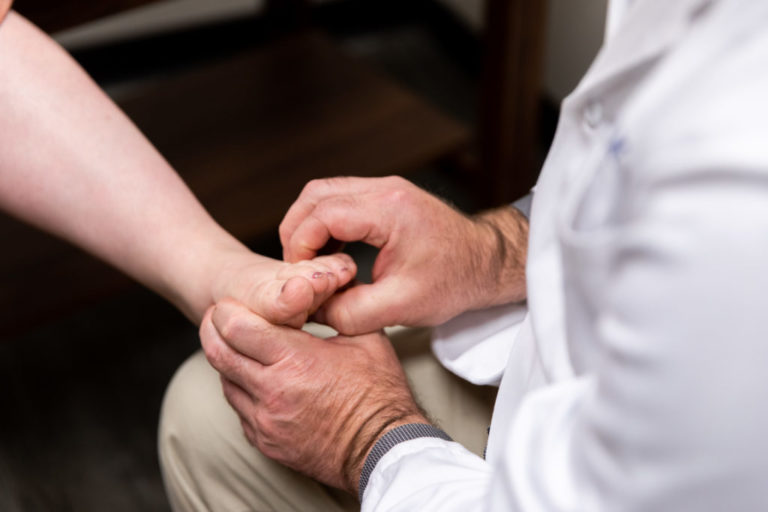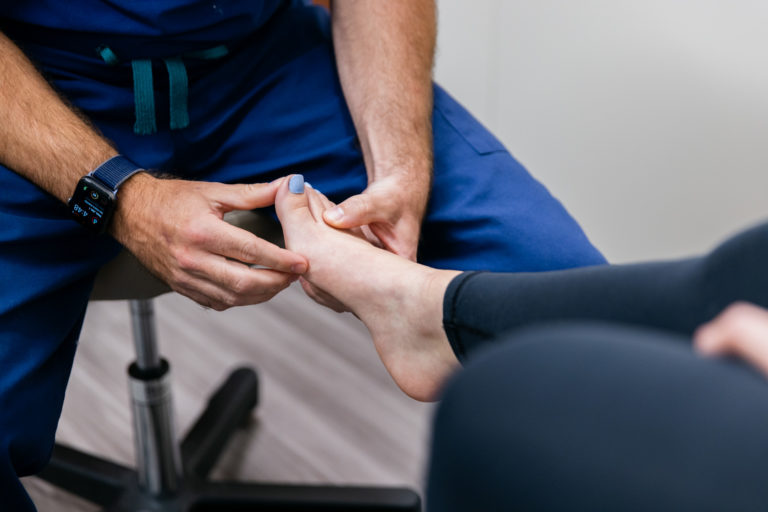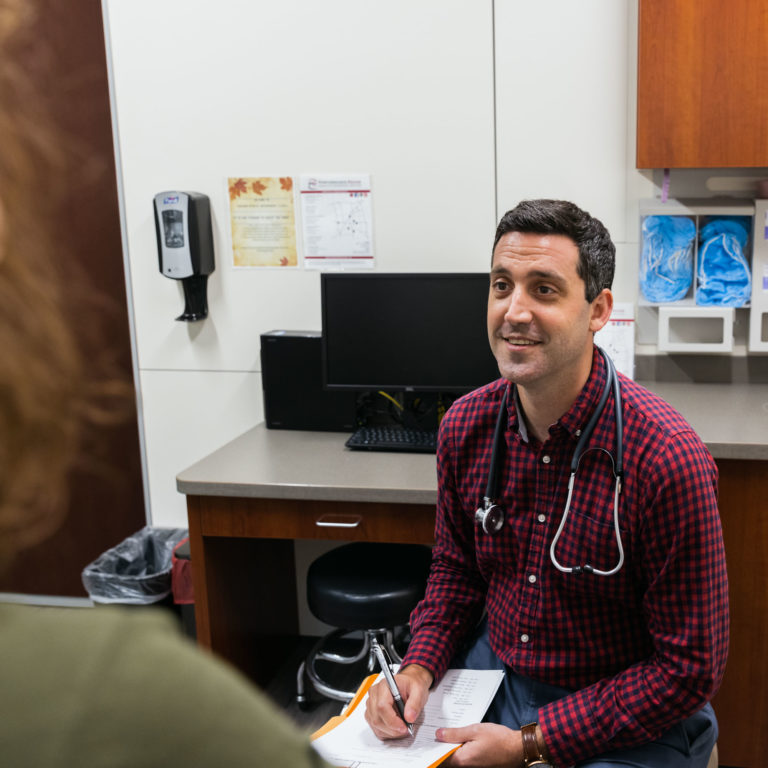Plantar Fasciitis Management in Kansas City
Plantar Fasciitis Management
Treat and manage your foot pain for long-term relief.

Understanding the Basics Behind Plantar Fasciitis
What is Plantar Fasciitis Management?
One of the most common sources of foot and heel pain is plantar fasciitis, and it can substantially limit your ability to perform daily tasks or participate in the activities you love.
Plantar fasciitis is characterized by a sharp, stabbing pain that shoots from your heel across the bottom of your foot. Oftentimes, this pain worsens throughout the day as you stay on your feet.
Though most people can be treated for plantar fasciitis without surgery, ignoring the issue can lead to further complications. In some cases, this issue can cause patients to change the way they walk, which can lead to other foot, ankle, hip, and leg issues. The providers at Kansas City Orthopedic Alliance are adept at plantar fasciitis management and can perform a number of treatments to correct the issue.
Our expert orthopedic foot and ankle physicians at Kansas City Orthopedic Alliance have the knowledge required to treat numerous issues, both surgically and non-surgically. When you visit a specialist at KCOA, we focus on creating a treatment plan based on your specific conditions, symptoms, and recovery goals.
Choosing plantar fasciitis management in Kansas City is a decision that typically involves guidance from your primary care doctor and orthopedic physician.
When you choose Kansas City Orthopedic Alliance, one of our highly-trained orthopedic foot and ankle specialists will conduct an initial evaluation to better understand your condition. After a complete review of your results, your provider will discuss whether treatment is the best treatment option for you.
Kansas City Orthopedic Alliance Foot & Ankle Injuries Assessment
Assessing the Injury
Determining the proper plantar fasciitis treatment process starts with an assessment from one of our experienced providers.
You can think of foot and ankle pain as a spectrum, with some instances being more severe than others. The KCOA orthopedic specialists always focus on each individual patient and their concerns before creating a treatment plan.
Therefore, during your initial appointment, we will often ask questions such as:
- When did your symptoms begin?
- Was there an event that started your symptoms?
- Did you notice or hear a popping sound at the time of your injury?
- Does your pain currently limit you or your activities?
- Has your pain progressed or worsened recently?
- Have you noticed any change in your symptoms that has made it more challenging to function?
- What are your lifestyle goals?
- How has pain affected those goals?
- What have you done to try and treat your symptoms?
From there, we can decide what treatment option will align best with your needs and lifestyle goals. Once we’ve completed a proper assessment, your provider will often begin with a physical examination to help determine the origin point of your pain. In some cases, advanced testing may be required for a full diagnosis.
Examinations
X-Ray
Also called radiographs, an X-ray captures a picture of the foot or ankle. Orthopedic physicians may order an X-ray to rule out the possibility of a fracture (broken bone), osteoarthritis, or other bone-related conditions.
Magnetic Resonance Imaging (MRI)
MRI captures images of muscles, bones, intervertebral discs, and tendons to help provide information other tests can’t detail. During an MRI, you will lie on a table that slides into a tube-shaped scanner. The machine creates a magnetic field around you, using pulsed radio waves to form the MRI images.
Symptoms
Common Signs and Symptoms of Foot & Ankle Injuries
With so many different parts working together in your feet and ankles, there are many potential causes of pain. And each of those causes has a unique set of symptoms.
Plantar fasciitis is quite common, with as many as 3 million new cases per year in the United States alone. Though you can normally treat the issue without surgery, plantar fasciitis can still cause considerable pain and worsen over time without treatment. Plantar fasciitis can be exacerbated by certain risk factors such as age, activity level, weight, the way you walk, and even the type of shoes you wear.
The symptoms of plantar fasciitis include:
- Pain at the bottom of the heel or in the arch of your foot
- Stiffness
- A feeling of warmth
- Increased pain after exercise
- Swelling
- Tightness in the Achilles tendon
- And more

Causes
Causes of Foot & Ankle Pain
The body has different kinds of joints, and they all face different challenges. The foot and ankle combine for a complex region of the body, totaling 26 bones and 33 small joints that constantly go through daily wear and tear. Soft tissue made up of muscles, tendons, ligaments, nerves, and blood vessels protects these joints and bones.
With all of these different bones in your feet and ankles, injuries become relatively common. As the years go on, many people struggle with the effects of years of repeated movements, such as walking, running, or jumping. This wear and tear can stress the soft tissue of your feet. Flattening or stretching of the tissue that forms the natural arch on the inside of your feet often leads to plantar fasciitis.
Treatment Alternatives
In most cases, surgery is not the first option for treatment at Kansas City Orthopedic Alliance. If we can treat your foot and ankle issues with more conservative treatments, we’ll choose those options. We typically exhaust all non-surgical options prior to recommending surgery. Non-surgical treatments for ankles and feet include:
Physical Therapy
Soft tissue mobilization and stretching of the plantar fascia and Achilles Tendon are often a focus of treatment. Your physical therapist might also recommend exercises designed to strengthen the muscles that stabilize the ankle and lower leg.
Orthotics
Proper fitting shoes and the use of custom orthotics can help relieve the symptoms of bunions and hammertoe, as well as alter the angle of the affected area.
Medications
Your doctor may recommend over-the-counter NSAIDs (Non-steroidal anti-inflammatory drugs, such as Advil)or prescription medications. Especially with NSAIDs, you should always talk to your doctor to ensure they are the right treatment for you.
Ice & Rest
A combination of ice and rest provides an opportunity for the affected area to reduce swelling. This combination can also help with pain management.
F.A.Q.
Frequently Asked Questions
Kansas City Orthopedic Alliance is here to help.
Our care is personal. Our team is knowledgeable. And we’re more available than ever.
With access to board-certified specialists across Kansas City, we have the tools to meet almost every musculoskeletal condition.
Our Locations
Overland Park, Kansas
10777 Nall Ave Suite 300 Overland Park, KS 66211Leawood, Kansas
3651 College Blvd. Leawood, KS 66211Kansas City, Missouri
Saint Luke's Medical Plaza #1 4320 Wornall Rd., Ste. 610 Kansas City, MO 64111Belton, Missouri
Belton Regional Campus 17067 S Outer Rd #301 Belton, MO 64012Blue Springs, Missouri
St. Mary’s Medical Center, Main Entrance 203 NW R.D. Mize Road, Suite 200 Blue Springs, MO 64014Shawnee Mission, Kansas
7450 Kessler St ste. 140 Merriam, KS 66204Prairie Star (Lenexa, Kansas)
Prairie Star 23401 Prairie Star PkwyBldg. B, Ste. 220 Lenexa, KS 66227





